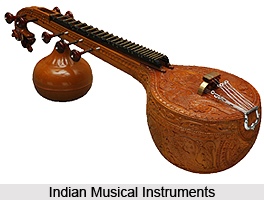 Scale of Indian Classical Music is based on the basic seven note system. The scale current today throughout India contains seven notes or "svars", and in order of ascent these are- Shadja, Rishabha, Ghandhara, Madhyama, Panchama, Dhaivata and Nishad, known however more popularly by their initials Sa, Ri, Ga, Ma, Pa, Dha, Ni. These seven notes form a cluster known as the "Saptak", and there are three such possible combinations or "Saptaks". Of these seven notes, with the exception of the Sa and Pa which are always constant and fixed and cannot be either flattened or sharpened, all the other five notes, besides having a fundamental variety in relation to each other, also have shades of delicate variations in themselves.
Scale of Indian Classical Music is based on the basic seven note system. The scale current today throughout India contains seven notes or "svars", and in order of ascent these are- Shadja, Rishabha, Ghandhara, Madhyama, Panchama, Dhaivata and Nishad, known however more popularly by their initials Sa, Ri, Ga, Ma, Pa, Dha, Ni. These seven notes form a cluster known as the "Saptak", and there are three such possible combinations or "Saptaks". Of these seven notes, with the exception of the Sa and Pa which are always constant and fixed and cannot be either flattened or sharpened, all the other five notes, besides having a fundamental variety in relation to each other, also have shades of delicate variations in themselves.
Apart from this semi tone, there is also seen in case of the scales in Indian Classical Music the Sruti which is one interval even smaller than the semi-tone. The use of this Sruti produces a difference in the melody of a particular note which is barely perceptible to the insensitive ear. Thus apart from the ordinary or "sudha ga," there are a variety of "gas" with tiny ripples of variations between them, such as the "komal ga" and the "ati komal ga" The same also is true of the other four notes, ri, ma, dha, and ni. With the help of these musical intervals, i.e., sudha, ati komal and komal svars, it is possible to have an infinite variety of scales. There could be a great number and variety of permutations and combinations. The Indian scale with all its Srutis has thus a very wide range and great possibilities of development in regard to musical formation. These infinite varieties are the basis from which the several "Raagas" have been developed. The Srutis themselves are supposed to produce different effects. They are Mridhu, soft; Madhia, intermediate between soft and pathetic; Karuna, pathetic; Dipta, brilliant; Ayata, stretched. It is sometimes possible to obtain a note by stretching the wire in a stringed instrument, a wee bit to one side, away from its fret; this gives a stretched intonation called the Ayata.
 Apart from these Srutis or musical intervals employed for the enrichment of the scale, there are certain other graces or ornamental themes used by the singer, which are different from these microtonal variations. These new variations are not separate notes and have no fixed character, depending only on the mood and imagination of the performing artist. These indefinite variations are known as "kuns" and are used only to ornament all the notes of the scale. It is interesting to know that originally these kuns were obtained by slightly shifting the frets of the solo string instruments, such as the Veena or the Sitar. This gives a clue how it is through the co-operation of the voice and the instrument that the musical scale is created and developed. These kuns employed in singing show the great flexibility which all the notes are capable of.
Apart from these Srutis or musical intervals employed for the enrichment of the scale, there are certain other graces or ornamental themes used by the singer, which are different from these microtonal variations. These new variations are not separate notes and have no fixed character, depending only on the mood and imagination of the performing artist. These indefinite variations are known as "kuns" and are used only to ornament all the notes of the scale. It is interesting to know that originally these kuns were obtained by slightly shifting the frets of the solo string instruments, such as the Veena or the Sitar. This gives a clue how it is through the co-operation of the voice and the instrument that the musical scale is created and developed. These kuns employed in singing show the great flexibility which all the notes are capable of.
It is now a fairly accepted theory that there are in all 22 notes including the Srutis, which form the basis of all the different scales. The sa has the privilege of being accepted as the starting point. According to ancient traditions even the sa was supposed to have one inflexible pitch, but the current practice now allows every singer or performer to choose his own pitch of sa, according to his inclinations and the timber of his voice.




















